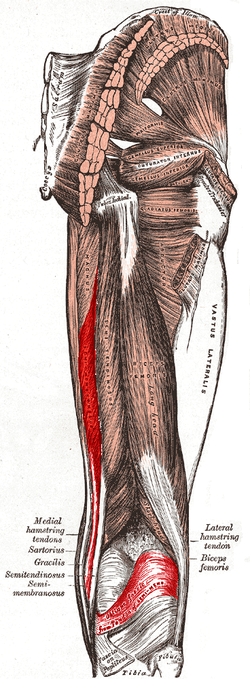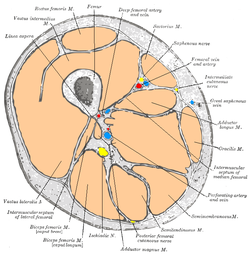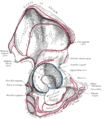- Semimembranosus muscle
-
Semimembranosus muscle Muscles of the gluteal and posterior femoral regions. Semimembranosus labeled at bottom left. Semimembranosus labeled at bottom right. Latin musculus semimembranosus Gray's subject #128 479 Origin Ischial tuberosity Insertion Medial surface of tibia Artery profunda femoris, gluteal artery Nerve sciatic (tibial, L5, S1, S2) Actions Hip extension, Knee flexion Antagonist Quadriceps muscle The semimembranosus is a muscle in the back of the thigh. It is the most medial of the three hamstring muscles.
Contents
Structure
The semimembranosus, so called from its membranous tendon of origin, is situated at the back and medial side of the thigh.
Its origin is the ischial tuberosity and it inserts on the medial condyle and nearby margin of tibia; intercondylar line and lateral condyle of femur; and the ligament of popliteal region. It arises by a thick tendon from the upper and outer impression on the tuberosity of the ischium, above and medial to the biceps femoris and semitendinosus.
The tendon of origin expands into an aponeurosis, which covers the upper part of the anterior surface of the muscle; from this aponeurosis muscular fibers arise, and converge to another aponeurosis which covers the lower part of the posterior surface of the muscle and contracts into the tendon of insertion.
It is inserted mainly into the horizontal groove on the posterior medial aspect of the medial condyle of the tibia.
The tendon of insertion gives off certain fibrous expansions: one, of considerable size, passes upward and laterally to be inserted into the posterior lateral condyle of the femur, forming part of the oblique popliteal ligament of the knee-joint; a second is continued downward to the fascia which covers the Popliteus muscle; while a few fibers join the tibial collateral ligament of the joint and the fascia of the leg.
The muscle overlaps the upper part of the popliteal vessels.
Innervation
The semimembranosus is innervated by the tibial nerve, a branch of the sciatic nerve. The tibial nerve consists of the anterior divisions of ventral nerve roots from L4 through S3. These nerve roots are part of a larger nerve network called the sacral plexus.[1] The tibial nerve is also responsible for innervating the skin of the posterior leg as well as plantar skin.
Actions
The semimembranosus helps to extend (straighten) the hip joint and flex (bend) the knee joint.
It also helps medially rotate the knee: the tibia medially rotates on the femur when the knee is flexed. Medially rotates the femur when the hip is extended. Can aid in counteracting the forward bending at the hip joint.[1]
Variations
It may be reduced or absent, or double, arising mainly from the sacrotuberous ligament and giving a slip to the femur or adductor magnus.
Additional images
See also
References
External links
- LUC semm
- SUNY Labs 14:st-0408
- SUNY Figs 14:01-07 - "Muscles (hamstrings) of the posterior compartment of the thigh."
- SUNY Figs 14:02-06 - "Muscles that form the superficial boundaries of the popliteal fossa."
- Anatomy at Dartmouth knee/surface/surface4
- PTCentral
This article was originally based on an entry from a public domain edition of Gray's Anatomy. As such, some of the information contained within it may be outdated.
List of muscles of lower limbs (TA A04.7, GA 4.465) ILIAC Region
/ ILIOPSOASBUTTOCKS THIGH /
compartmentsLEG/
Crus/
compartmentssuperficial · triceps surae (gastrocnemius, soleus, accessory soleus, Achilles tendon) · plantaris
deep · tarsal tunnel (flexor hallucis longus, flexor digitorum longus, tibialis posterior) · popliteusfibularis muscles (longus, brevis)FOOT DorsalPlantar1st layer (abductor hallucis, flexor digitorum brevis, abductor digiti minimi) · 2nd layer (quadratus plantae, lumbrical muscle) · 3rd layer (flexor hallucis brevis, adductor hallucis, flexor digiti minimi brevis) · 4th layer (dorsal interossei, plantar interossei)Categories:- Hip extensors
- Hip medial rotators
- Knee flexors
- Knee medial rotators
- Thigh muscles
Wikimedia Foundation. 2010.




